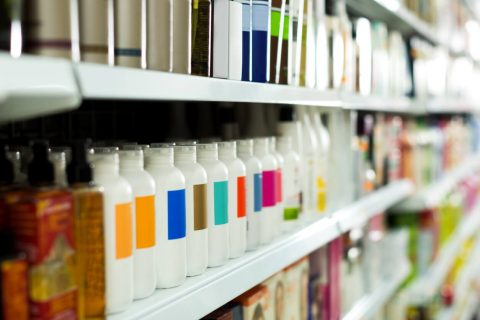Personal Care Products
Each year, Americans spend tens of billions of dollars on personal care products designed to enhance their skin, hair and hygiene. What many consumers don’t realize is that the cosmetic products they are regularly applying to their body are subject to little governmental oversight and no mandatory safety testing.

The average adult uses about nine personal care products every day — and most consumers don’t give their daily regimen a second thought. They simply trust that the shampoo, sunscreen, deodorant and other cosmetics they’re using are safe.
But that’s not always the case. Between 2014 and 2018, consumers made more than 27,000 complaints to the U.S. Food & Drug Administration about cosmetics they suspected harmed them. An examination of those records by Consumer Notice revealed injuries ranging from allergic reactions to hair loss to chemical burns to infections to cancer.
Advocacy groups such as the Environmental Working Group and The Breast Cancer Fund warn that some personal care products contain potentially harmful chemicals that could lead to long-term health risks. And an antiquated regulatory framework, which hasn’t been updated (except for color additives) since 1938, prevents the FDA from doing much about it.
Limited Federal Scrutiny of Cosmetics
The federal government heavily regulates food, drugs and even pesticides. But cosmetics aren’t subject to the same level of government oversight. It should be noted, however, that some personal care products are regulated as drugs by the FDA because of the ingredients they contain or the health and therapeutic claims their manufacturers make. Others may be regulated as medical devices, dietary supplements or consumer products.
- Fluoride-containing toothpaste
- Antidandruff shampoo
- Antiperspirant deodorants
- Moisturizers and makeup that claim to protect from the sun
- Some hair removal devices
- Vitamins and minerals
- Manicure sets
The FDA can turn to the Department of Justice and federal courts for restraining orders, seizures or criminal actions to stop the sale of mislabeled or contaminated cosmetic products that are available to the public. However, the agency doesn’t vet cosmetics before they hit store shelves. In fact, manufacturers don’t have to tell the government watchdog much of anything about their products — not the ingredients they use, where their products are manufactured, or even what their safety data shows.
Instead, the cosmetics industry essentially polices itself. Ingredient safety is decided by the Cosmetic Ingredient Review (CIR), an industry-funded panel of scientific and medical experts that meets three times a year to assess the safety of chemicals used in cosmetics. The group is funded by the Personal Care Products Council, the main trade association for the cosmetic industry.
The term “cosmetics,” according to the FDA, encompasses a wide variety of personal care products including:
- Makeup and nail polishes
- Perfumes and colognes
- Shaving products
- Skin moisturizers, lotions, and creams
- Face and body cleansers
- Shampoos
- Deodorants
- Toothpaste
- Baby oils and lotions
- Hair care products, dyes, conditioners, straighteners/relaxers, perms
- Hair removal creams
- Tattoos and permanent makeup
- Temporary tattoos and face paint
The FDA’s hands are also tied in other ways. The agency has no authority to issue mandatory product recalls — and it can’t require manufacturers to report cosmetic-related injuries. Instead, companies report them on a voluntary basis, which often leads to the underreporting of problems.
“We estimate that the adverse event reports we receive represent only a fraction of the actual number of cosmetic-related problems,” Dayle Cristinzio, the FDA’s acting associate commissioner for legislation, said in a 2016 letter to Sen. Dianne Feinstein (D-Calif.). “The lack of reliable information makes it difficult to assess the true nature of problems with cosmetics and can delay efforts to respond to the complaints.”
A prime example of this was when the FDA received 127 complaints from consumers who developed hair loss and other problems after using WEN Hair Cleansing Conditioner by stylist Chaz Dean. An inspection by the FDA revealed that the manufacturer and distributor of the products had received 21,000 direct complaints about irritation, hair breakage, hair loss and baldness.
The law does not require cosmetic companies to report problems to FDA. Therefore, your report is very important in order to help keep the cosmetics market safe.
The hair care company denied its products caused people’s hair to fall out, but it ended up paying $27 million to settle a class-action lawsuit brought by consumers. But according to the FDA, it’s still not known what might have caused the reactions.
“We don’t have enough information to determine the cause of these reported reactions [to the WEN products],” the FDA stated on its website. “[T]he law does not require cosmetic companies to share their safety data or consumer complaints with the FDA.”
Trade Secrets and Undisclosed Fragrances
Unfortunately, vague labels, lax regulations and a lack of transparency by manufacturers can make it hard to determine what ingredients are lurking in your toiletries bag.
Cosmetic manufacturers are not required to share the formulations of their products with the FDA — though some choose to do so voluntarily. Even when they do share, they don’t disclose the quantities of the ingredients they use.
While cosmetic companies are required by law to list ingredients on labels in descending order of predominance, there are several loopholes in this rule. Under a trade-secret exemption, manufacturers are not required to list ingredients that are considered “trade secrets” on product labels. Instead, they need merely to add the phrase “and other ingredients” to the end of the product’s ingredient list.
They also don’t have to list the specific ingredients used to give the product a specific scent or flavor. Instead, they can just list the term “fragrance” or “flavor” on the label. If chemicals are added to a product to cover an undesirable smell, they can also be disclosed simply as “fragrance.” And if levels of the masking agent are low enough, it doesn’t have to be disclosed at all.
Controversial Products and Chemicals
WEN hair conditioner isn’t the only personal care product generating headlines in recent years.
In 2016, a Virginia man filed suit against Procter & Gamble after experiencing severe chemical burns to his underarms after using Old Spice deodorant just a handful of times. A class-action lawsuit he filed (but that eventually got dismissed) cited hundreds of other complaints on the Internet by consumers who also experienced similar reactions to Old Spice deodorants.
In a statement to the media, Procter & Gamble defended the safety of its products and attributed such reactions to alcohol sensitivity. The company said consumers who experience problems might find antiperspirant a “better option,” because it is formulated differently.
Over the past decade, thousands of women have sued Johnson & Johnson, alleging that the company’s iconic baby powder caused them to develop ovarian cancer. Other talcum powder lawsuits have been filed by individuals who claim the product caused them to come down with mesothelioma, a rare and fatal cancer usually associated with asbestos.
Johnson & Johnson vigorously denies allegations that its talc products contribute to cancer.
Unsafe Ingredients
While the talc controversy is playing out in courtrooms across the nation, safety advocates worry that the cumulative effects of repeated exposure to a variety of other common chemicals in cosmetics might also cause unanticipated health problems.
Many types of cosmetics, for instance, contain parabens and phthalates — substances that the Campaign for Safe Cosmetics says can disrupt hormone function and may raise the risk of some types of cancer.
Parabens — which are often used as preservatives in makeup, shampoo and other cosmetics — have been shown in laboratory tests to increase the migratory and invasive activity of breast cancer cells. Some studies have linked high urine levels of parabens to low testosterone levels, sperm DNA damage and slow-moving sperm.
Phthalates — which function as binding agents in perfume, hairspray and a number of personal hygiene products — have also been linked to sperm DNA damage in adults. And birth defects of male genitalia and reproductive systems have been linked to mothers with high urinary concentrations of the chemicals.
While the European Union has limited the use of some parabens and phthalates in cosmetics, the United States has not followed suit.
On its website, the FDA says it’s continuing to study the safety of parabens but doesn’t have any information at this time showing that the chemicals “as they are used in cosmetics” affect human health. The agency is also monitoring the levels of phthalates, but says it’s “not clear what effect, if any” the chemicals have on humans.
According to the New York State Health Foundation, other potentially toxic chemicals commonly found in personal care products include:
- Butylated Hydroxyanisole (BHA)
- BHA, often found in makeup, has been found to cause stomach and liver cancer in animals. The National Toxicology program classifies the chemical as “reasonably assumed to be a human carcinogen.”
- Formaldehyde
- This common ingredient in hair straightening products and nail hardeners is a known human carcinogen that’s been linked to cancers of the nose and throat as well as certain types of leukemia.
- 1,4-Dioxane
- This chemical is a “probable” human carcinogen that has caused kidney and liver damage in lab animals. That said, it’s not required to be listed on product ingredient lists, because it’s a byproduct of the manufacturing process.
- Triclosan
- While the FDA has banned the use of triclosan in hand sanitizers and body washes, it’s still a common ingredient in toothpaste. The chemical has been linked to an increased risk of allergies and hay fever in children and has been shown in laboratory animals to suppress thyroid function.
- Sodium Laurethsulfate (SLS)
- Contrary to postings on the Internet, SLS hasn’t been linked to cancer. But this common ingredient in toothpaste, shampoos and other products can cause irritation of the eyes, skin and lungs.
Steps Toward Safer Use
If you’re concerned about the safety of the cosmetic and personal care products you’re using, there are several steps you can take to try and limit your exposure to harmful substances.
A good starting point is to research the products you’re using and become acquainted with their ingredients. The EWG’s Skin Deep Cosmetics Database is a treasure trove of information, with ingredient data on about nearly 70,000 products.
You can search the database by product name, brand, manufacturer or ingredient. Best of all, the Skin Deep database assesses each product’s ingredients, describes the concerns associated with those ingredients and assigns it a “hazard key score” of 1 to 10. A score of 1 to 2 represents a “low hazard,” 3 to 6 represents a “moderate hazard” and 8 to 10 puts it in the “high hazard” range.
Another valuable resource is the California Safe Cosmetics Program Product Database (CSCP). It includes information on cosmetic products with ingredients known to or suspected of causing cancer, birth defects and reproductive harm. You can search by specific chemical ingredient or product name. The CSCP is also one of the few sources of flavor and fragrance information used in cosmetics.
Northeastern University’s PROTECT program advises consumers to avoid harmful chemicals in cosmetics by doing the following:
- Avoid products that contain parabens and phthalates as ingredients
- Avoid perfumes and other products with fragrance
- Look for “fragrance-free” products, rather than unscented ones
- Avoid nail polish and hairspray, which contain phthalates and other toxins
- Avoid cosmetics that contain placenta, placental extract, estrogen or other hormones
- Cover up with clothes and umbrellas instead of dousing in chemical sunscreen and using sunscreen products that contain zinc oxide, or avobenzon (3 percent)
- Take shorter showers to lessen the length of time you’re inhaling airborne chemicals or absorbing them through open pores
If you are concerned about a product, you may want to eliminate it from your beauty routine. Other ways to reduce your exposure to potential hazards includes making your own products or using fewer products in general. The Campaign for Safe Cosmetics, a project of Breast Cancer Prevention Partners, suggests choosing products that have been screened and certified by the non-profit organization MADE SAFE as safe and non-toxic.
If you have a bad reaction to a cosmetic, stop using it immediately, contact your doctor and report the problem to the FDA. The FDA has consumer complaint coordinators you can call directly or you can file a complaint online through the FDA’s MedWatch Voluntary Reporting Form for consumers.
“The law does not require cosmetic companies to report problems to FDA,” according to the agency. “Therefore, your report is very important in order to help keep the cosmetics market safe.”
35 Cited Research Articles
Consumernotice.org adheres to the highest ethical standards for content production and references only credible sources of information, including government reports, interviews with experts, highly regarded nonprofit organizations, peer-reviewed journals, court records and academic organizations. You can learn more about our dedication to relevance, accuracy and transparency by reading our editorial policy.
- Silverstein, J. (2016, March 27). Old Spice deodorant leaves ‘thousands’ of consumers with armpit rashes and burns, lawsuit says. Daily News. Retrieved from https://www.nydailynews.com/news/national/old-spice-deodorant-painful-armpit-rashes-lawsuit-article-1.2579354
- Kelly, C. (2018, November 21). The truth about talc, parabens and 8 other controversial makeup ingredients. USA Today. Retrieved from https://www.usatoday.com/story/news/investigations/2018/11/21/talc-parabens-makeup-ingredients-safe-toxic/2002867002/
- U.S. Food and Drug Administration. (2018, August 8). Fragrances in Cosmetics. Retrieved from https://www.fda.gov/cosmetics/cosmetic-ingredients/fragrances-cosmetics
- California Department of Public Health. (n.d.) California Safe Cosmetics Program Product Database. Retrieved from https://safecosmetics.cdph.ca.gov/search/Default.aspx
- KABC EYEWITNESS NEWS abc7. (2016, March 2018). Old Spice deodorant causes painful rashes, burns, lawsuit claims. Retrieved from https://abc7.com/news/old-spice-deodorant-causes-painful-rashes-burns-lawsuit-claims/1265913/
- Barrett, J. (2005, January). Chemical Exposures: The Ugly Side of Beauty Products. Retrieved from https://www.ncbi.nlm.nih.gov/pmc/articles/PMC1253722/
- Breast Cancer Prevention Partners. (n.d.). Right to Know: Exposing Toxic Fragrance Chemicals Report. Retrieved from https://www.bcpp.org/resource/right-to-know-exposing-toxic-fragrance-chemicals-report/
- California Department of Public Health. (2016, August). Cosmetics Containing Ingredients Linked to Cancer or Reproductive Harm. Retrieved from https://www.cdph.ca.gov/Programs/CCDPHP/DEODC/OHB/CSCP/CDPH%20Document%20Library/DataReport.pdf
- California Department of Public Health. (n.d.). California Safe Cosmetics Program Product Database. Retrieved from https://safecosmetics.cdph.ca.gov/search/products.aspx
- Campaign for Safe Cosmetics. (n.d.). Parabens. Retrieved from http://www.safecosmetics.org/get-the-facts/chemicals-of-concern/parabens/
- Campaign for Safe Cosmetics. (n.d.). Phthalates. Retrieved from http://www.safecosmetics.org/get-the-facts/chemicals-of-concern/phthalates/
- Cristinzio, D. (2016, October 5). Letter to The Honorable Dianne Feinstein. Retrieved from https://www.feinstein.senate.gov/public/_cache/files/2/6/2619f3d2-f537-405c-b6e0-759aacb7d09c/C2C841EA1ADC6C76FC295473995A1A24.response-feinstein-cosmetics.pdf
- Environmental Working Group. (n.d.) Exposures add up — Survey results. Retrieved from https://web.archive.org/web/20110505175317/https://www.ewg.org/skindeep/2004/06/15/exposures-add-up-survey-results/
- Feinstein, D. & Collins, S. (2018, May). Viewpoint: The Personal Care Products Safety Act. Retrieved from https://www.feinstein.senate.gov/public/index.cfm/op-eds?ID=CFFA2261-11AE-4A11-A3BA-971B514BA40B
- Grand View Research. (2018, January). U.S. Personal Care Products Market Size, Share & Trends Analysis Report By Product (Skincare, Haircare, Personal Hygiene, Make-up, Fragrances, Oral Hygiene), Competitive Landscape, And Segment Forecasts, 2018-2025. Retrieved from https://www.grandviewresearch.com/industry-analysis/us-personal-care-products-market
- Harvard T.H. Chan School of Public Health. (2014, February 13). Harmful, untested chemicals rife in personal care products. Retrieved from https://www.hsph.harvard.edu/news/features/harmful-chemicals-in-personal-care-products/
- Harvard T.H. Chan School of Public Health. (n.d.). Choosing personal care products with fewer ingredients may reduce risks from harmful chemicals. Retrieved from https://www.hsph.harvard.edu/news/hsph-in-the-news/personal-care-products-health-risks/
- Lipton, E. & Abrams, R. (2016, August 15). Their Hair Fell Out: Should the FDA Have the Power to Act? Retrieved from https://www.nytimes.com/2016/08/16/us/politics/cosmetics-industry-congress-regulation-wen.html
- Narayan, P. (2018, August 2). The cosmetics industry has avoided strict regulation for over a century. Now rising health concerns has FDA inquiring. Retrieved from https://www.cnbc.com/2018/08/01/fda-begins-first-inquiry-of-lightly-regulated-cosmetics-industry.html
- National Institute of Environmental Health Sciences. (2014, September 14). Chemicals in Personal Care Products. Retrieved from https://www.niehs.nih.gov/research/supported/translational/peph/podcasts/2014/sept14_consumer-health/index.cfm
- Northeastern University. (n.d.). PROTECT Yourself: Avoiding Harmful Chemicals in Personal Care Products. Retrieved from https://web.northeastern.edu/protect/for-the-public-the-media/resource-center/protect-yourself-keeping-harmful-chemicals-out-of-your-life/protect-yourself-avoiding-harmful-chemicals-in-personal-care-products/
- NYS Health Foundation. (n.d.). FACT SHEET: Potentially Toxic Chemicals In Personal Care Products. Retrieved from https://nyshealthfoundation.org/wp-content/uploads/2019/03/potentially-toxic-chemicals-personal-care-products-march-2019.pdf
- United States District Court for the Southern District of Ohio. (2016, March 11). Rodney Colley v. Procter & Gamble. Retrieved from https://sqps.onstreamsecure.com/origin/multivu_archive/ENR/Complaint%20-%20FILED%20COPY.pdf
- University of Rochester Medical Center. (2007, March 14). Phthalates Now Linked to Fat, Related Health Risks. Retrieved from https://web.archive.org/web/20191115121243/https://www.urmc.rochester.edu/news/story/1405/phthalates-now-linked-to-fat-related-health-risks.aspx
- U.S. Food and Drug Administration. (2016, May 22). Are all “personal care products” regulated as cosmetics? Retrieved from https://www.fda.gov/industry/fda-basics-industry/are-all-personal-care-products-regulated-cosmetics
- U.S. Food and Drug Administration. (2018, July 30). Consumer Complaint Coordinators. Retrieved from https://www.fda.gov/safety/report-problem-fda/consumer-complaint-coordinators
- U.S. Food and Drug Administration. (2017, November 5). Cosmetic Labeling Guide. Retrieved from https://www.fda.gov/cosmetics/cosmetics-labeling-regulations/cosmetics-labeling-guide
- U.S. Food and Drug Administration. (2013, August 3). FDA Authority Over Cosmetics: How Cosmetics are Not FDA-Approved, but Are FDA-Regulated. Retrieved from https://www.fda.gov/cosmetics/cosmetics-laws-regulations/fda-authority-over-cosmetics-how-cosmetics-are-not-fda-approved-are-fda-regulated
- U.S. Food & Drug Administration. (2017, November 3). How to Report a Cosmetic Related Complaint. Retrieved from https://www.fda.gov/cosmetics/cosmetics-compliance-enforcement/how-report-cosmetic-related-complaint
- U.S. Food & Drug Administration. (2018, October 16). CFSAN Adverse Event Reporting System (CAERS). Retrieved from https://www.fda.gov/food/compliance-enforcement-food/cfsan-adverse-event-reporting-system-caers
- U.S. Food & Drug Administration. (2017, November 13). FDA Information for Consumers About WEN By Chaz Dean Cleansing Conditioners. Retrieved from https://www.fda.gov/cosmetics/cosmetic-products/fda-information-consumers-about-wen-chaz-dean-cleansing-conditioners
- U.S. Food & Drug Administration. (n.d.). MedWatch Voluntary Report. Retrieved from https://www.accessdata.fda.gov/scripts/medwatch/index.cfm?action=consumer.reporting1
- U.S. Food & Drug Administration. (2018, February 22). Parabens in Cosmetics. Retrieved from https://www.fda.gov/cosmetics/cosmetic-ingredients/parabens-cosmetics
- U.S. Food & Drug Administration. (2018, February 22). Phthalates. Retrieved from https://www.fda.gov/cosmetics/cosmetic-ingredients/phthalates
- Washam, C. (2006, July). Legislation: California Enacts Safe Cosmetics Act. Retrieved from https://www.ncbi.nlm.nih.gov/pmc/articles/PMC1513294/
Calling this number connects you with a Consumer Notice, LLC representative. We will direct you to one of our trusted legal partners for a free case review.
Consumer Notice, LLC's trusted legal partners support the organization's mission to keep people safe from dangerous drugs and medical devices. For more information, visit our partners page.
844-420-1914


